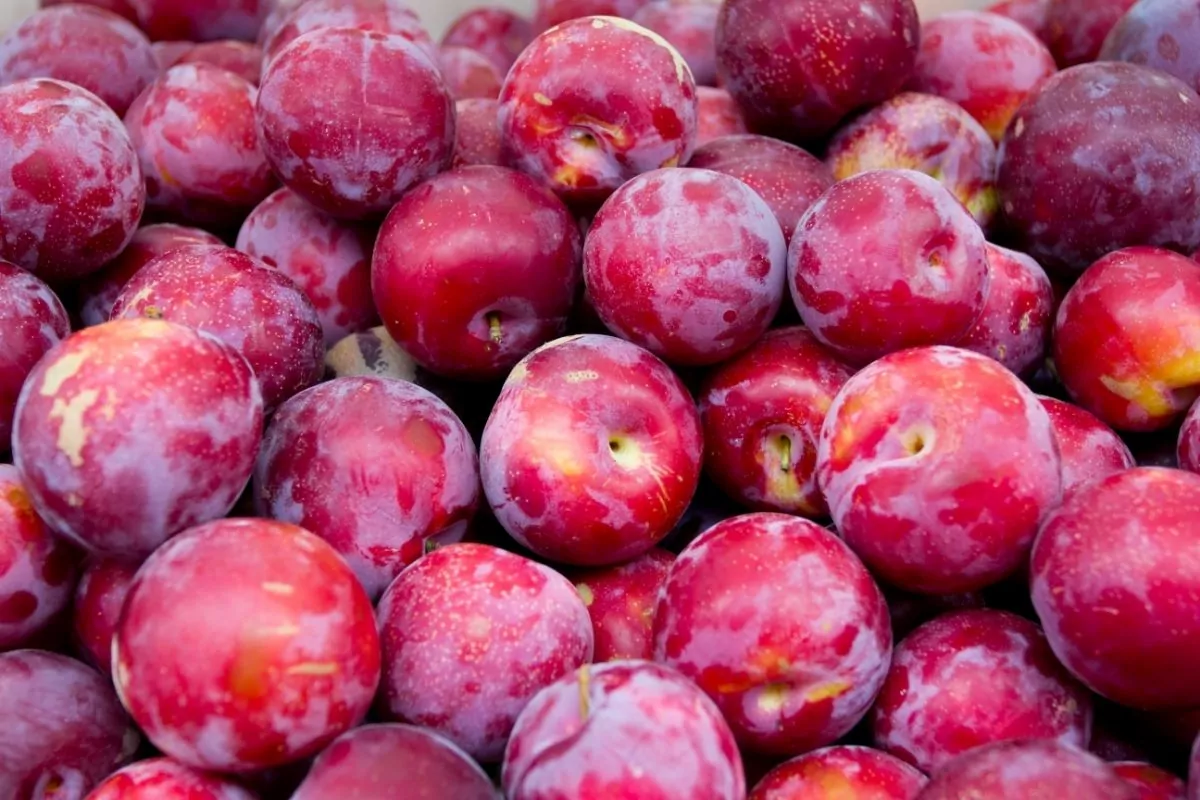Dogs and Plums
The honest answer to “can dogs eat plums ?” lies within the parts of the plum consumed. Dogs and plums go together like chalk and cheese because there are risks owners need to consider.
Plums form a part of the Prunus genus in the Rosaceae family. Common cultivars include the Prunus Domestica and Prunus Americana. In addition, the cocoplum hedge’s fruit or Icacos Fruta is also considered a type of plum.

Why Are Plums The Pits For Dogs?
There are several reasons why plums are not suitable to feed to dogs. However, the portion of the plum which is of most concern is the plum pit.
The first concern around the pit is the risk it poses as a foreign body when ingested. If chewed, the edges of the pit can become sharp and abrasive. In addition, pit ingestion can lead to mucosal damage to the esophagus, stomach, or intestinal lining.
Obstruction in the gastrointestinal tract is a significant risk to small dog breeds or dogs who consume several pits at once. The build-up of pits can lead to a stomach outflow obstruction or an intestinal blockage. Obstructions caused by foreign bodies can range in severity, often resulting in hospitalization or surgery.
The flesh of plum is not toxic, but it is high in sugar. Overripe, fermented, or moldy plum flesh can lead to gastrointestinal upsets and may result in episodes of vomiting or diarrhea. In addition, the high sugar content of plums may result in rapid weight gain if fed regularly.
The main factors that make plums toxic to dogs involve the following portions of the plum plant – the pit, the flowers, the stem, and the roots. These specific plant parts contain toxins such as hydrogen cyanide, prunasin, amygdalin, and cyanogen.
Even consuming small portions of the components listed above release toxins that can result in the following symptoms:
- Muscle tremors.
- Congested mucous membranes (bright red color).
- Vomiting.
- Difficulty breathing.
- Abdominal cramping.
- Dilated pupils.
- Ataxia or seizures.
- Confusion or distress.
- Loss of consciousness.
- Respiratory failure.
- Death.
Can Dogs Eat Dried Plums?
Dried plums are also known as prunes. Prunes are not toxic to dogs, but they can cause gastrointestinal upsets due to their poor digestibility. Ingestion of prunes can cause dogs’ vomiting, diarrhea, abdominal discomfort, or depressed appetites. Prunes also contain a very high sugar content that is unhealthy for dogs.
Feeding a dried plum for dogs’ constipation is also not advisable as it may cause severe diarrhea.
Can Dogs Eat Cherry Plums?
Cherry plums also contain hydrogen cyanide. The toxin has a high concentration in the pit. The roots and foliage of the cherry plum tree are also dangerous for dogs and can cause gastric irritation and possibly respiratory distress if consumed in excess.
Are Plums Good for Dogs?
The consensus is that plums are not an ideal food for dogs. The basic constitution of plums lacks many essential nutrients and has an extremely high glycemic index. Along with the concerns around pit ingestion, the risk of feeding plums is not worth the reward.
How Are Plum Pits Toxic to Canines?
Plum pits and plum trees’ leaves, stems, and roots contain cyanogenic glycosides.
β-Glucosidase and hydroxy nitrile lyase are enzymes that convert glycosides into cyanide.
The cyanide binds to the iron molecule in cytochrome oxidase. As a result, it blocks the electron transport system of the red blood cell, thereby inhibiting oxygen transport from the blood to the tissues.
The electron transport blockage is why the mucous membranes become bright red as the blood cannot unload oxygen. The red blood cells simply circulate without being able to fulfill their purpose of oxygen delivery.
The paradoxical cascade of oxygen-rich cherry red blood that cannot offload oxygen leads to oxygen depletion in the peripheral tissues. Ultimately symptoms progress from increased breathing, weakness, collapse, respiratory paralysis, and agonal convulsions to death.
Can Puppies Eat Plums?
Puppies have very sensitive digestive tracts. They are still developing their immunity, and their growth is extremely rapid, so they have particular dietary requirements.
The high sugar content of plums is considered inappropriate for the diet of a growing puppy. In addition, the risk of immune compromise, diabetes, and weight gain is not ideal. The toxicity and obstruction hazard of the plum pits also make plums an unfavorable puppy snack.

The Health Benefits of Plums to Dogs
The benefits of plums are not as vast as other fruits or vegetables, but they are high in vitamin A and C. Vitamin A contributes to eye and skin health, and vitamin C aids in supporting the immune system.
Health Concerns Feeding Dogs Plums
The primary health concerns if dogs eat plums are the risks of toxicity and obstruction.
Severe toxicities will result in hydrogen cyanide poisoning, respiratory failure, and eventual death.
The symptoms occur very quickly, which does not leave owners with much time to react. However, if you are lucky enough to realize your pet has ingested plum pits, then it is best to reach out to a vet as soon as possible.
The choking and obstruction hazard of plum pits in small breed dogs is noteworthy, so always be aware of where you discard plums or their pits.
Diabetes and obesity are a growing concern in private practice. The high sugar content of plums is something owners need to consider before feeding their dogs plums. Unregulated blood sugar levels are not healthy for pets.
How to Safely Feed Plums to Your Dog
If fed strictly in moderation and without the pip, plum flesh can be safe for dogs. However, fruits and other treats should not make up more than 10 percent of your dog’s daily nutritional intake, so monitor how much fruit your pet eats.
Other safer fruit options include apples, watermelon, blueberries, and bananas.
FAQs on Plums and Dogs
What Should I Do If My Dog Swallows a Plum Stone?
In cases where your pet has swallowed one or more plum pits, contact a veterinarian immediately. A single pit in a medium or large breed dog may not be a big problem, but it can increase the risk of choking, gastrointestinal upsets, obstruction, or toxicity in small breed dogs.
Owners need to monitor their pets for signs of poisoning, bowel obstruction, abdominal discomfort, or respiratory distress.
Should I Induce Vomiting If My Dog Ate a Plum?
If your pet only ingested the fruit’s flesh and not the pit, it is unnecessary to induce vomiting.
Inducing vomiting can be pretty stressful for dogs. If owners notice that their pet has consumed several plums, it would be best to take the pet to a vet instead so that staff can closely monitor emesis induction in a controlled environment.

Plum Tuckered Out?
Pet owners often feel the need to bring variety into their pet’s diet. People love plums, but they are not ideal treats for our furry friends. Introducing plums into a pet’s diet is easy, but it does not come highly recommended. Owners need to acknowledge the risk of feeding plums and be mindful of where they dispose of the plum flesh or pits.
The high sugar content and the risk of toxicity need to come into careful consideration before one decides to feed plums as a treat. We advise other safer fruits or vegetables as an alternative to plums to ensure that your pet’s health and safety come first.
